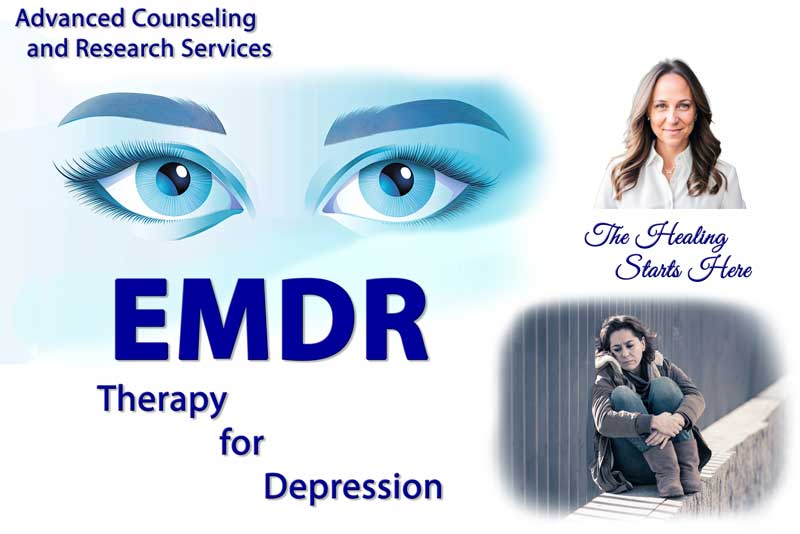EMDR Therapy for Depression: Heal and Reclaim Your Life


313 West Liberty Street, Ste. 224
Lancaster, PA 17603

Why Choose ACRS for Depression EMDR Therapy?
EMDR Therapy, which stands for Eye Movement Desensitization and Reprocessing Therapy, is an evidence-based approach used by ACRS-licensed professionals in PTSD, Trauma, and Depression Counseling. We will help you assess whether EMDR Therapy is the proper treatment for your unique needs. We are conveniently located in downtown Lancaster and offer the highest quality In-Person EMDR Therapy in Pennsylvania.
If in-office visits are problematic, we offer the highest quality Online Telehealth EMDR Therapy.
EMDR Therapy is an excellent treatment modality for Depression. However, ACRS clinicians utilize several proven effective techniques.
Click here to discover all the Therapeutic Modalities and Mental Health Services ACRS offers.
ACRS Trauma-Informed experts will work with you to determine the best modality or combination of modalities you need to get better and reclaim your life after Trauma.
You are not alone; healing is possible, and your healing starts here.
Contact Us today!
What is EMDR Therapy?
How Can EMDR Therapy Help With Depression?
- Reprocesses Unresolved Trauma: Depression often originates from past traumatic events or distressing experiences, even those that might not initially appear impactful. These unresolved experiences can remain "frozen" in the brain, perpetuating feelings of pain and sadness. EMDR helps the brain reprocess and integrate these memories more healthily. By addressing the root cause—be it a specific trauma or repetitive negative thought patterns—EMDR empowers individuals to break free from depression's grip.
- Transforms Negative Beliefs: Many individuals with depression struggle with deeply rooted and harmful beliefs, such as "I am not good enough," "I am powerless," or "I am a failure." These beliefs not only contribute to depression but also perpetuate it. EMDR rewires the emotional responses tied to these beliefs and replaces them with healthier, more adaptive perspectives. For example, after undergoing EMDR therapy, someone who previously felt "I am powerless" may begin to embrace the belief, "I survived, and I am strong."
- Reduces Emotional Numbness and Distress: A common symptom of depression is emotional numbness or being overwhelmed by persistent distress. EMDR helps desensitize emotional triggers, reducing the intensity of emotional pain associated with difficult experiences. By processing unresolved emotions and memories, individuals often report feeling a sense of relief, calmness, and greater emotional clarity, making it easier to regain control of their thoughts and feelings.
- Addresses Physical Symptoms of Depression: Depression is not merely a mental health condition—it often manifests physically through symptoms like chronic fatigue, headaches, or body tension. EMDR acknowledges the mind-body connection and can reduce physical discomfort by addressing the emotional stress trapped in the body. Many individuals leave EMDR sessions feeling physically lighter, energized, and more at ease.
- Enhances Emotional Regulation: Managing overwhelming emotions can be particularly challenging for those with depression. EMDR promotes improved emotional processing, allowing individuals to respond to stress and negativity healthier and more balanced. Over time, this enhanced emotional regulation builds resilience and bolsters one's ability to recover from emotional setbacks.
- Empowers Individuals to Overcome Helplessness: Depression often leaves individuals feeling powerless or stuck, but EMDR provides a structured and empowering path for healing. By reprocessing painful past experiences, individuals can transform old wounds into sources of strength. EMDR sessions offer a tangible sense of progress and control, boosting confidence in one's ability to overcome challenges
- Delivers Faster Progress in Many Cases: Unlike some forms of therapy that may take years to show results, EMDR often produces noticeable improvements within a few sessions. These rapid results mainly motivate individuals whose depression stems from specific triggers or trauma. The faster pace of change encourages individuals to stay engaged in their journey toward recovery.
- Works Well for Individuals Resistant to Traditional Talk Therapies: For some, discussing deep emotional pain or revisiting traumatic experiences during traditional talk therapy can feel overwhelming or even counterproductive. EMDR provides a unique alternative because it does not require detailed verbal recounting of these events. Instead, it uses guided eye movements and other forms of bilateral stimulation to help individuals process distressing memories and reduce their emotional intensity.
How Does EMDR Therapy Work?
EMDR Therapy Uses Three Core Components
Bilateral Stimulation
EMDR Therapy involves the use of Bilateral Stimulation (typically through guided eye movements) to help you process and integrate traumatic memories.
Imagine your brain like a computer. When you experience something traumatic, it's like a file that gets stuck and won't process correctly. This "stuck" file can cause a lot of problems, like flashbacks, anxiety, and trouble sleeping. EMDR is like a special program that helps your brain process that stuck file.
The "Bilateral Stimulation" part is like pressing a special button that gets the processing going. Therapists can activate this button in a few ways:
- Eye Movements: You follow the therapist's finger moving back and forth, like watching a tennis match.
- Tapping: Your therapist taps your hands or shoulders, alternating from left to right.
- Sounds: You listen to alternating tones through headphones.
This back-and-forth stimulation seems to help both sides of your brain communicate better, which helps to "unstick" the traumatic memory.
While doing this, you'll think about the memory, but the stimulation helps mitigate the bad feelings. Over time, this process helps your brain to file the memory correctly, so it doesn't cause as much distress anymore. It's like defragmenting your computer's hard drive so everything runs smoother.
In simpler terms, EMDR uses back-and-forth stimulation (like eye movements or tapping) to help your brain process traumatic memories causing problems. It's like a mental reset button that enables you to heal.
Desensitization
Desensitization helps reduce the emotional charge of distressing memories, allowing you to reprocess these experiences more healthily.
Imagine you have a terrible memory that keeps popping into your head, making you anxious or upset. It's like a scary scene from a movie that you can't stop replaying. EMDR Desensitization is like reducing the volume on that frightening scene. Here's how it works:
Think about the memory: You bring the upsetting memory to mind, along with any bad feelings, thoughts, and body sensations connected to it.
Do the eye movements (or taps): While thinking about the memory, you follow the therapist's fingers moving back and forth across your vision, or they might tap your hands or shoulders. This back-and-forth motion is called Bilateral Stimulation.
Notice what happens: As you do the eye movements or tapping, you might notice the memory becoming less clear, less upsetting, or even changing in some way. The bad feelings might start to fade. This is the Desensitization part – the memory is losing its power to upset you. Your brain can finally process the memory healthily, so it doesn't cause as much distress.
Think of it like this:
Before EMDR: The memory is like a loud, scary movie scene that keeps repeating in your head.
During EMDR: Eye movements or tapping help your brain "rewind" and "reprocess" the scene, reducing the volume and its scariness.
After EMDR: The memory is still there, but it's like a regular movie scene now – you can remember it without feeling overwhelmed by fear or sadness.
Important to remember: EMDR doesn't erase the memory. It just takes away the intense emotional pain that goes with it.
Reprocessing
Your therapist guides you to reframe negative beliefs and develop more adaptive coping strategies.
Imagine your brain like a filing cabinet. When you experience something traumatic, that memory gets filed incorrectly, maybe in the "danger" or "emergency" section. Every time you think about it, your brain reacts as if the danger is happening right now, causing stress.
EMDR reprocessing is like refiling that memory in the correct place, the "past events" section. This helps your brain understand that the danger is over and you're safe now. Here's how it works:
Focus on the memory: You bring the upsetting memory to mind, along with any bad feelings, thoughts, and body sensations connected to it.
Do the eye movements (or taps): While focusing on the memory, you follow the therapist's fingers moving back and forth across your vision, or they might tap your hands or shoulders. This is the Bilateral Stimulation.
Let your brain do its thing: Eye movements or tapping seem to help your brain process the memory in a new way. It's like your brain is returning to the original event and saying, "Okay, that happened, but it's over now."
New connections: As you reprocess the memory, you might have new thoughts and insights about what happened. For example, someone who felt responsible for a car accident might realize it wasn't their fault.
What Should I Expect in an EMDR Session?
Eight Phases of EMDR Therapy
- Initial Consultation: During your first session, we will discuss your emotional concerns and treatment goals.
- Preparation: You will learn about EMDR and how the process works to ensure you feel comfortable and safe.
- Assessment: We will identify specific memories and triggers to target during the sessions.
- Desensitization: Through guided eye movements, we will help you process distressing memories.
- Installation: Positive beliefs will be reinforced to replace negative thoughts.
- Body Scan: This phase helps identify any lingering physical tension related to the trauma.
- Closure: Each session concludes with a relaxation technique to ensure you feel grounded.
- Re-evaluation: We will check in on your progress in subsequent sessions.
Frequently Asked Questions About EMDR
What is EMDR Therapy?
EMDR stands for Eye Movement Desensitization and Reprocessing. It is a psychotherapy designed to help individuals process and heal from traumatic experiences. EMDR combines bilateral stimulation, typically through guided eye movements, with cognitive processing to help clients reframe and integrate distressing memories.
Is EMDR effective?
Numerous studies have shown EMDR to be effective in treating trauma-related disorders, particularly Post-Traumatic Stress Disorder (PTSD). The therapy has been endorsed by various health organizations, including the World Health Organization (WHO) and the American Psychiatric Association, as an effective treatment for trauma.
Is EMDR Safe?
Yes, EMDR is a safe and effective therapeutic approach that is well-researched. Visit the American Psychological Association to find out more.
Is EMDR evidenced-based?
Yes. EMDR Therapy is recognized as an evidence-based treatment for PTSD and trauma by organizations such as the American Psychological Association (APA) and the World Health Organization (WHO).
Is EMDR covered by insurance?
Is EMDR Therapy covered by insurance?
Many health insurance plans cover EMDR therapy, especially if it is deemed necessary for treating PTSD or other mental health issues. It’s advisable to check with your insurance provider to understand your coverage options. Contact Us for help in finding out if you're covered.
Are there any side effects associated with EMDR Therapy?
Yes. Click the following link to discover the Side Effects of EMDR Therapy.
How do I find a qualified EMDR Therapist?
Look for professionals who are certified by EMDR International Association (EMDRIA) or who have completed EMDR training from reputable programs.
What mental conditions are treated with EMDR Therapy?
- Post-Traumatic Stress Disorder (PTSD): EMDR is most well-known for its effectiveness in treating PTSD, helping individuals process and reduce the distress associated with traumatic memories.
- Anxiety Disorders: EMDR can help individuals address anxiety disorders, including generalized anxiety disorder (GAD), panic disorder, and specific phobias by processing the underlying traumatic experiences or anxiety triggers.
- Depression: EMDR may be beneficial for individuals dealing with depression, particularly when traumatic experiences contribute to their depressive symptoms.
- Complex PTSD: Individuals with complex PTSD, which may arise from prolonged trauma or multiple traumatic events, can benefit from the EMDR approach to help process these experiences.
- Borderline Personality Disorder (BPD): Some studies suggest that EMDR can be effective in helping individuals with BPD by addressing trauma and associated emotional dysregulation.
- Childhood Trauma: EMDR is used to treat individuals who have experienced childhood trauma, including abuse and neglect, helping them to process and heal from those experiences.
- Grief and Loss: EMDR can aid individuals in processing grief and loss, helping them to work through the emotions associated with losing a loved one.
- Substance Use Disorders: EMDR may be utilized as part of a comprehensive treatment plan for individuals struggling with substance use disorders, especially when trauma plays a role in their addiction.
- Performance Anxiety: EMDR can assist individuals in overcoming performance-related anxiety, such as stage fright or public speaking anxiety, by addressing any underlying fears or past negative experiences.
- Chronic Pain and Illness: Some practitioners have used EMDR to help individuals with chronic pain and illness by addressing the emotional and psychological components associated with their condition.
How many sessions will I need?
The number of sessions varies based on individual needs and the complexity of trauma.
What can I expect in an EMDR Therapy session?
An EMDR session typically lasts about 60 to 90 minutes. Initially, your therapist will conduct an assessment and discuss your treatment goals. Then, during the actual EMDR processing, you will be guided to focus on specific memories while following the therapist's fingers with your eyes or using other forms of bilateral stimulation. Clients often report feeling a range of emotions, but the goal is to achieve a sense of clarity and relief.
Can EMDR Therapy be done virtually online?
Yes, EMDR can be conducted virtually online through telehealth platforms, provided that the therapist is trained to deliver EMDR in this format. ACRS has the required training and experience to conduct EMDR online.
Virtual EMDR sessions generally use similar techniques as in-person sessions. Click the following link to discover more about Virtual Online EMDR Therapy.
Can EMDR be combined with other therapies?
Yes, EMDR can be integrated with other therapeutic approaches. Many therapists use EMDR alongside cognitive-behavioral therapy (CBT), mindfulness practices, and other treatments to provide comprehensive care tailored to individual client needs.
Can EMDR be administered in a group setting?
Yes, EMDR can be performed in a group setting, but it’s less common than individual therapy. Group EMDR might be useful for specific situations, such as support groups for trauma survivors or in workshops focused on shared experiences. However, the effectiveness and comfort level can vary from person to person, so it's important to choose the setting that feels right for each individual’s healing process.
ACRS EMDR Therapists for Depression
Our counselors are trained in Trauma-Informed Care and have extensive experience helping individuals heal from traumatic experiences.
Chief Executive Officer

- Licensed Professional Counselor (LPC);
- Pa. Lic. PC006514
- Fl. Lic. TPMC1044
- Certified Traumatologist (CT)
- National Certified Counselor (NCC)
- Certified Clinical Mental Health Counselor (CCMHC)
- Certified Clinical Trauma Professional (CCTP)
- Certified in Emergency Crisis Response (CECR)
- Master of Arts (MA)
- 20+ years of clinical experience.
- Worked with clients across the lifespan.
Cheryl Wilson-Smith
Chief Executive Officer

- Licensed Professional Counselor (LPC);
- Pa. Lic. PC006514
- Fl. Lic. TPMC1044
- Certified Traumatologist (CT)
- National Certified Counselor (NCC)
- Certified Clinical Mental Health Counselor (CCMHC)
- Certified Clinical Trauma Professional (CCTP)
- Certified in Emergency Crisis Response (CECR)
- Master of Arts (MA)
- 20+ years of clinical experience.
- Worked with clients across the lifespan.
Cheryl Wilson-Smith is a distinguished expert in EMDR therapy and proudly holds the position of Chief Clinical Officer. Her dedication to healing and transformative care sets her apart in the field, making a meaningful impact on countless lives.
"I have over 20 years of experience in In-Person and Online EMDR Depression Therapy. I guarantee that the EMDR Therapy for Depression ACRS provides to clients is of the highest quality in Pennsylvania".

